SKODA FABIA 2009 2.G / 5J Owners Manual
Manufacturer: SKODA, Model Year: 2009, Model line: FABIA, Model: SKODA FABIA 2009 2.G / 5JPages: 259, PDF Size: 31.99 MB
Page 91 of 259
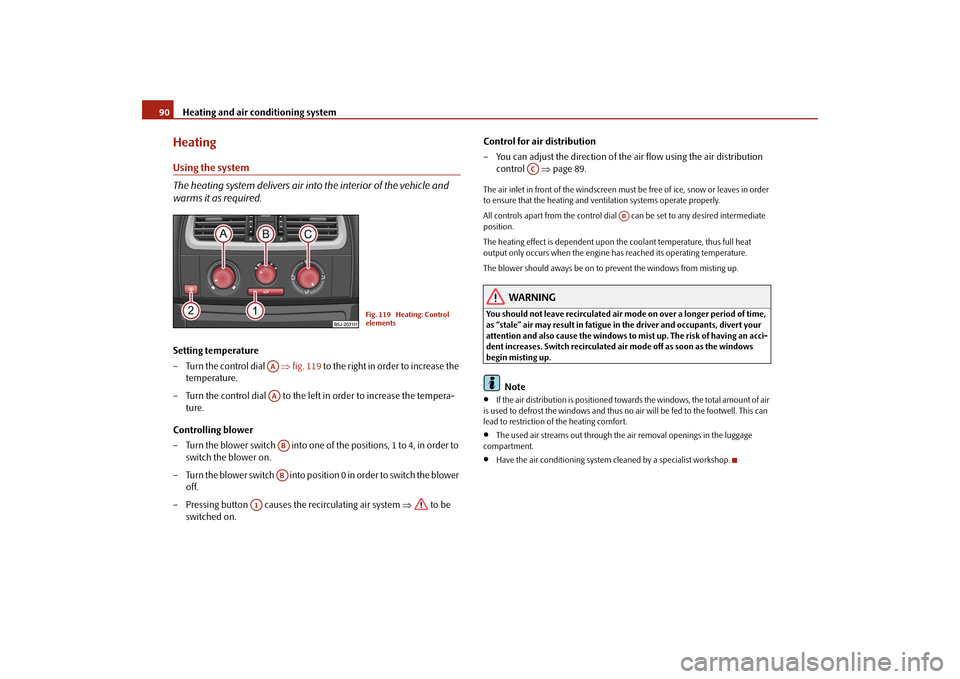
Heating and air conditioning system 90HeatingUsing the system
The heating system delivers air into the interior of the vehicle and
warms it as required.Setting temperature
– Turn the control dial ⇒fig. 119 to the right in order to increase the
temperature.
– Turn the control dial to the left in order to increase the tempera-
ture.
Controlling blower
– Turn the blower switch into one of the positions, 1 to 4, in order to
switch the blower on.
– Turn the blower switch into position 0 in order to switch the blower
off.
– Pressing button causes the recirculating air system ⇒ to be
switched on.Control for air distribution
– You can adjust the direction of the air flow using the air distribution
control ⇒page 89.
The air inlet in front of the windscreen must be free of ice, snow or leaves in order
to ensure that the heating and ventilation systems operate properly.
All controls apart from the control dial can be set to any desired intermediate
position.
The heating effect is dependent upon the coolant temperature, thus full heat
output only occurs when the engine has reached its operating temperature.
The blower should aways be on to prevent the windows from misting up.
WARNING
You should not leave recirculated air mode on over a longer period of time,
as “stale” air may result in fatigue in the driver and occupants, divert your
attention and also cause the windows to mist up. The risk of having an acci-
dent increases. Switch recirculated air mode off as soon as the windows
begin misting up.
Note
•
If the air distribution is positioned towards the windows, the total amount of air
is used to defrost the windows and thus no air will be fed to the footwell. This can
lead to restriction of the heating comfort.
•
The used air streams out through the air removal openings in the luggage
compartment.
•
Have the air conditioning system cleaned by a specialist workshop.
Fig. 119 Heating: Control
elements
AAAAABAB
A1
AC
AB
s3f4.1.book Page 90 Thursday, June 18, 2009 11:07 AM
Page 92 of 259
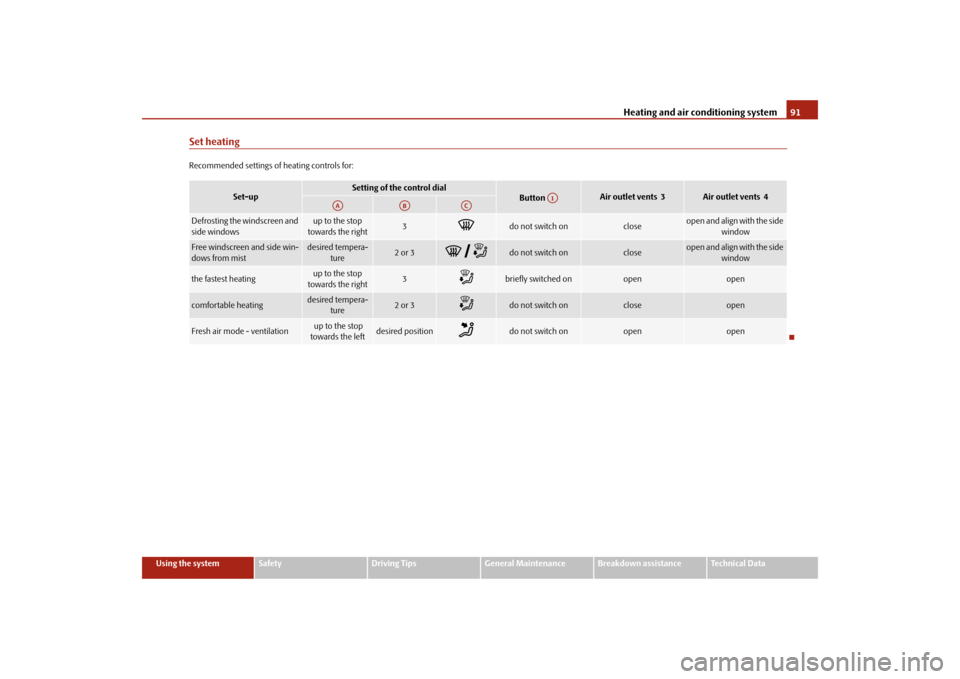
Heating and air conditioning system91
Using the system
Safety
Driving Tips
General Maintenance
Breakdown assistance
Technical Data
Set heatingRecommended settings of heating controls for:
Set-up
Setting of the control dial
Button
Air outlet vents 3
Air outlet vents 4
Defrosting the windscreen and
side windows
up to the stop
towards the right
3
do not switch on
close
open and align with the side
window
Free windscreen and side win-
dows from mist
desired tempera-
ture
2 or 3
do not switch on
close
open and align with the side
window
the fastest heating
up to the stop
towards the right
3
briefly switched on
open
open
comfortable heating
desired tempera-
ture
2 or 3
do not switch on
close
open
Fresh air mode - ventilation
up to the stop
towards the left
desired position
do not switch on
open
open
A1
AA
AB
AC
s3f4.1.book Page 91 Thursday, June 18, 2009 11:07 AM
Page 93 of 259
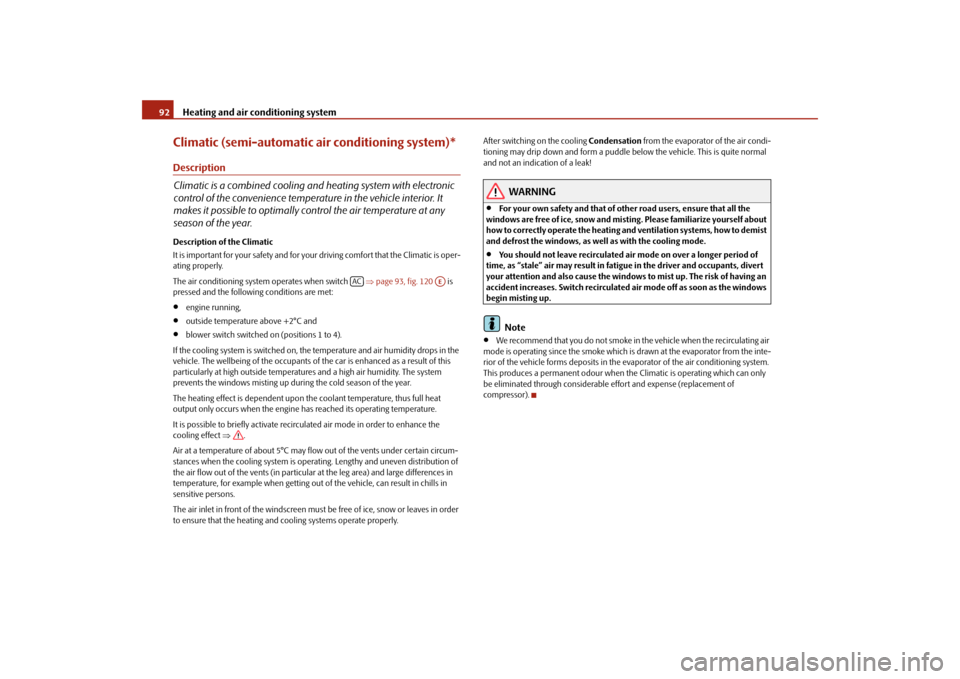
Heating and air conditioning system 92Climatic (semi-automatic air conditioning system)*Description
Climatic is a combined cooling and heating system with electronic
control of the convenience temperature in the vehicle interior. It
makes it possible to optimally control the air temperature at any
season of the year.Description of the Climatic
It is important for your safety and for your driving comfort that the Climatic is oper-
ating properly.
The air conditioning system operates when switch ⇒page 93, fig. 120 is
pressed and the following conditions are met:•
engine running,
•
outside temperature above +2°C and
•
blower switch switched on (positions 1 to 4).
If the cooling system is switched on, the temperature and air humidity drops in the
vehicle. The wellbeing of the occupants of the car is enhanced as a result of this
particularly at high outside temperatures and a high air humidity. The system
prevents the windows misting up during the cold season of the year.
The heating effect is dependent upon the coolant temperature, thus full heat
output only occurs when the engine has reached its operating temperature.
It is possible to briefly activate recirculated air mode in order to enhance the
cooling effect ⇒.
Air at a temperature of about 5°C may flow out of the vents under certain circum-
stances when the cooling system is operating. Lengthy and uneven distribution of
the air flow out of the vents (in particular at the leg area) and large differences in
temperature, for example when getting out of the vehicle, can result in chills in
sensitive persons.
The air inlet in front of the windscreen must be free of ice, snow or leaves in order
to ensure that the heating and cooling systems operate properly.After switching on the cooling Condensation from the evaporator of the air condi-
tioning may drip down and form a puddle below the vehicle. This is quite normal
and not an indication of a leak!
WARNING
•
For your own safety and that of other road users, ensure that all the
windows are free of ice, snow and misting. Please familiarize yourself about
how to correctly operate the heating and ventilation systems, how to demist
and defrost the windows, as well as with the cooling mode.
•
You should not leave recirculated air mode on over a longer period of
time, as “stale” air may result in fatigue in the driver and occupants, divert
your attention and also cause the windows to mist up. The risk of having an
accident increases. Switch recirculated air mode off as soon as the windows
begin misting up.Note
•
We recommend that you do not smoke in the vehicle when the recirculating air
mode is operating since the smoke which is drawn at the evaporator from the inte-
rior of the vehicle forms deposits in the evaporator of the air conditioning system.
This produces a permanent odour when the Climatic is operating which can only
be eliminated through considerable effort and expense (replacement of
compressor).
AC
AE
s3f4.1.book Page 92 Thursday, June 18, 2009 11:07 AM
Page 94 of 259
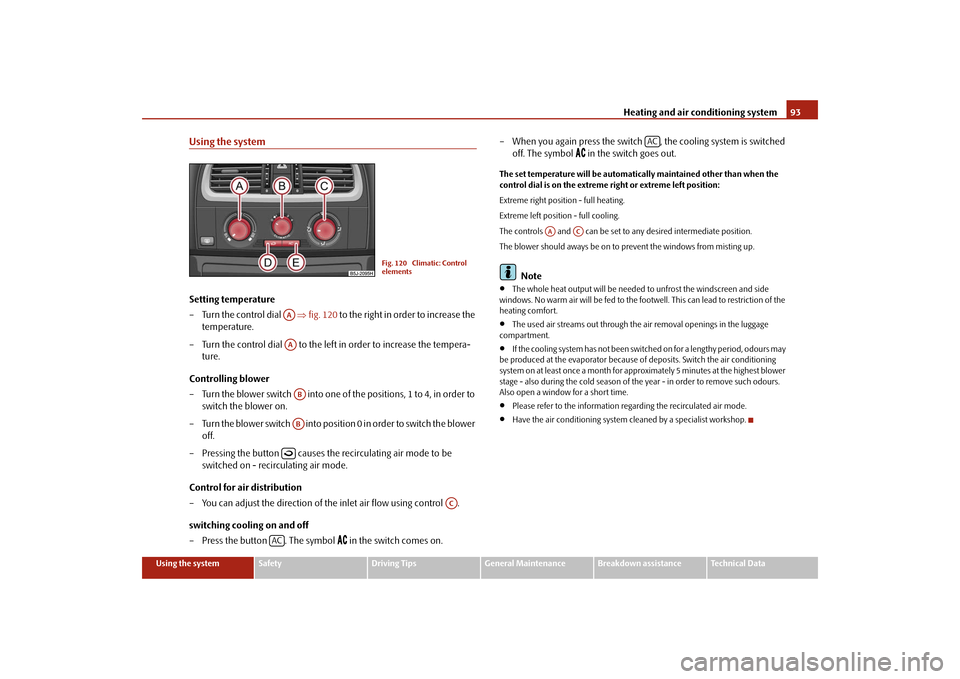
Heating and air conditioning system93
Using the system
Safety
Driving Tips
General Maintenance
Breakdown assistance
Technical Data
Using the systemSetting temperature
– Turn the control dial ⇒fig. 120 to the right in order to increase the
temperature.
– Turn the control dial to the left in order to increase the tempera-
ture.
Controlling blower
– Turn the blower switch into one of the positions, 1 to 4, in order to
switch the blower on.
– Turn the blower switch into position 0 in order to switch the blower
off.
– Pressing the button causes the recirculating air mode to be
switched on - recirculating air mode.
Control for air distribution
– You can adjust the direction of the inlet air flow using control .
switching cooling on and off
– Press the button . The symbol
in the switch comes on.– When you again press the switch , the cooling system is switched
off. The symbol
in the switch goes out.
The set temperature will be automatically maintained other than when the
control dial is on the extreme right or extreme left position:
Extreme right position - full heating.
Extreme left position - full cooling.
The controls and can be set to any desired intermediate position.
The blower should aways be on to prevent the windows from misting up.
Note
•
The whole heat output will be needed to unfrost the windscreen and side
windows. No warm air will be fed to the footwell. This can lead to restriction of the
heating comfort.
•
The used air streams out through the air removal openings in the luggage
compartment.
•
If the cooling system has not been switched on for a lengthy period, odours may
be produced at the evaporator because of deposits. Switch the air conditioning
system on at least once a month for approximately 5 minutes at the highest blower
stage - also during the cold season of the year - in order to remove such odours.
Also open a window for a short time.
•
Please refer to the information regarding the recirculated air mode.
•
Have the air conditioning system cleaned by a specialist workshop.
Fig. 120 Climatic: Control
elements
AAAAABAB
AC
AC
AC
AA
AC
s3f4.1.book Page 93 Thursday, June 18, 2009 11:07 AM
Page 95 of 259
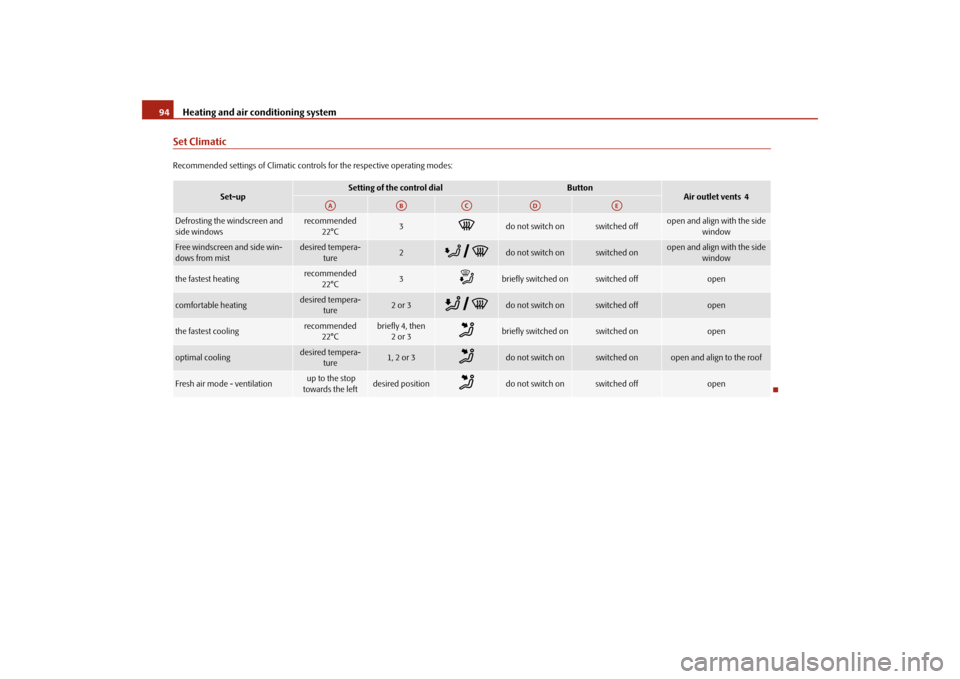
Heating and air conditioning system 94Set ClimaticRecommended settings of Climatic controls for the respective operating modes:
Set-up
Setting of the control dial
Button
Air outlet vents 4
Defrosting the windscreen and
side windows
recommended
22°C
3
do not switch on
switched off
open and align with the side
window
Free windscreen and side win-
dows from mist
desired tempera-
ture
2
do not switch on
switched on
open and align with the side
window
the fastest heating
recommended
22°C
3
briefly switched on
switched off
open
comfortable heating
desired tempera-
ture
2 or 3
do not switch on
switched off
open
the fastest cooling
recommended
22°C
briefly 4, then
2or 3
briefly switched on
switched on
open
optimal cooling
desired tempera-
ture
1, 2 or 3
do not switch on
switched on
open and align to the roof
Fresh air mode - ventilation
up to the stop
towards the left
desired position
do not switch on
switched off
open
AA
AB
AC
AD
AE
s3f4.1.book Page 94 Thursday, June 18, 2009 11:07 AM
Page 96 of 259
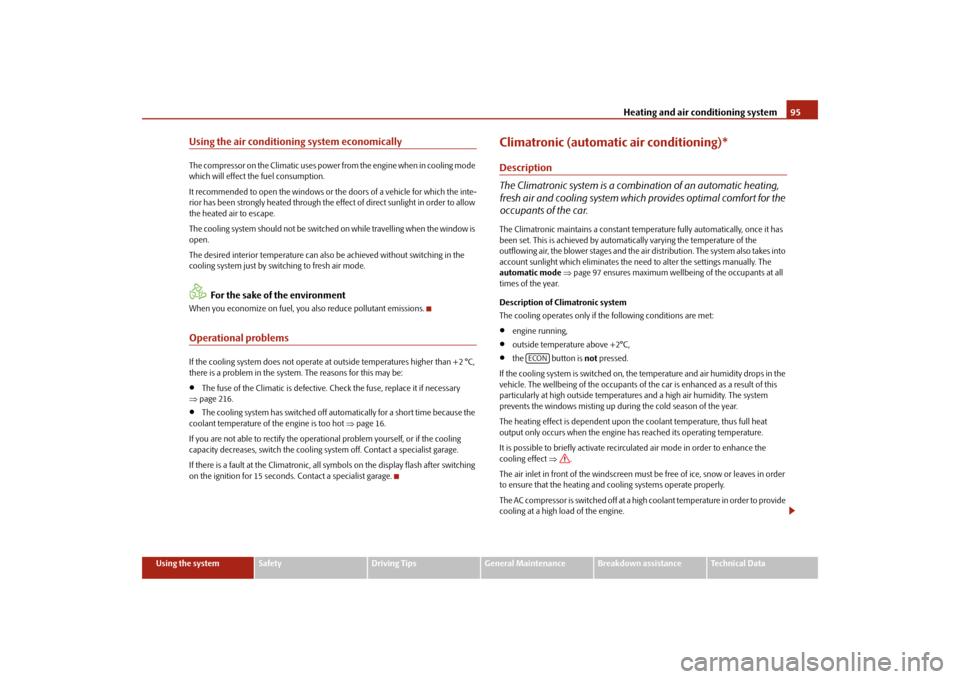
Heating and air conditioning system95
Using the system
Safety
Driving Tips
General Maintenance
Breakdown assistance
Technical Data
Using the air conditioning system economicallyThe compressor on the Climatic uses power from the engine when in cooling mode
which will effect the fuel consumption.
It recommended to open the windows or the doors of a vehicle for which the inte-
rior has been strongly heated through the effect of direct sunlight in order to allow
the heated air to escape.
The cooling system should not be switched on while travelling when the window is
open.
The desired interior temperature can also be achieved without switching in the
cooling system just by switching to fresh air mode.
For the sake of the environment
When you economize on fuel, you also reduce pollutant emissions.Operational problemsIf the cooling system does not operate at outside temperatures higher than +2 °C,
there is a problem in the system. The reasons for this may be:•
The fuse of the Climatic is defective. Check the fuse, replace it if necessary
⇒page 216.
•
The cooling system has switched off automatically for a short time because the
coolant temperature of the engine is too hot ⇒page 16.
If you are not able to rectify the operational problem yourself, or if the cooling
capacity decreases, switch the cooling system off. Contact a specialist garage.
If there is a fault at the Climatronic, all symbols on the display flash after switching
on the ignition for 15 seconds. Contact a specialist garage.
Climatronic (automatic air conditioning)*Description
The Climatronic system is a combination of an automatic heating,
fresh air and cooling system which provides optimal comfort for the
occupants of the car.The Climatronic maintains a constant temperature fully automatically, once it has
been set. This is achieved by automatically varying the temperature of the
outflowing air, the blower stages and the air distribution. The system also takes into
account sunlight which eliminates the need to alter the settings manually. The
automatic mode ⇒page 97 ensures maximum wellbeing of the occupants at all
times of the year.
Description of Climatronic system
The cooling operates only if the following conditions are met:•
engine running,
•
outside temperature above +2°C,
•
the button is not pressed.
If the cooling system is switched on, the temperature and air humidity drops in the
vehicle. The wellbeing of the occupants of the car is enhanced as a result of this
particularly at high outside temperatures and a high air humidity. The system
prevents the windows misting up during the cold season of the year.
The heating effect is dependent upon the coolant temperature, thus full heat
output only occurs when the engine has reached its operating temperature.
It is possible to briefly activate recirculated air mode in order to enhance the
cooling effect ⇒.
The air inlet in front of the windscreen must be free of ice, snow or leaves in order
to ensure that the heating and cooling systems operate properly.
The AC compressor is switched off at a high coolant temperature in order to provide
cooling at a high load of the engine.
ECON
s3f4.1.book Page 95 Thursday, June 18, 2009 11:07 AM
Page 97 of 259

Heating and air conditioning system 96After switching on the cooling Condensation from the evaporator of the air condi-
tioning may drip down and form a puddle below the vehicle. This is quite normal
and not an indication of a leak!
Recommended setting for all periods of the year:•
Set the temperature to 22 °C.
•
Press the button ⇒fig. 121.
•
Move the air outlet vents 3 and 4, so that the air flow is directed slightly
upwards.
Switching over between degrees Celsius and degrees Fahrenheit
Press and hold the buttons and ⇒fig. 121. The information in the
desired temperature measuring unit appears in the display.
WARNING
•
For your own safety and that of other road users, ensure that all the
windows are free of ice, snow and misting. Please familiarize yourself about
how to correctly operate the heating and ventilation systems, how to demist
and defrost the windows, as well as with the cooling mode.
•
You should not leave recirculated air mode on over a longer period of
time, as “stale” air may result in fatigue in the driver and occupants, divert
your attention and also cause the windows to mist up. The risk of having an
accident increases. Switch recirculated air mode off as soon as the windows
begin misting up.Note
•
If the cooling system has not been switched on for a lengthy period, odours may
be produced at the evaporator because of deposits. Switch the cooling system on
at least once a month for approximately 5 minutes at the highest blower stage - also
during the cold season of the year - in order to remove such odours. Also open a
window for a short time.
•
We recommend that you do not smoke in the vehicle when the recirculating air
mode is operating since the smoke which is drawn at the evaporator from the inte-
rior of the vehicle forms deposits in the evaporator of the air conditioning system. This produces a permanent odour when the air conditioning system is operating
which can only be eliminated through considerable effort and expense (replace-
ment of compressor).
•
The used air streams out through the air removal openings in the luggage
compartment.
•
Using the cooling economically ⇒page 95.
•
Operational problems ⇒page 95.
Overview of the control elementsFig. 121 Climatronic: Control elementsButtons / control dial
Setting the blower speed
The displays
Set blower speed
The outside temperature
Climatronic fault, have the vehicle inspected by a specialist garage
Air flow to the windows
Recirculated air mode
Air flow to the head, upper body and feet
AUTO
ECON
AUTO
A1A2A3A4A5A6A7
s3f4.1.book Page 96 Thursday, June 18, 2009 11:07 AM
Page 98 of 259
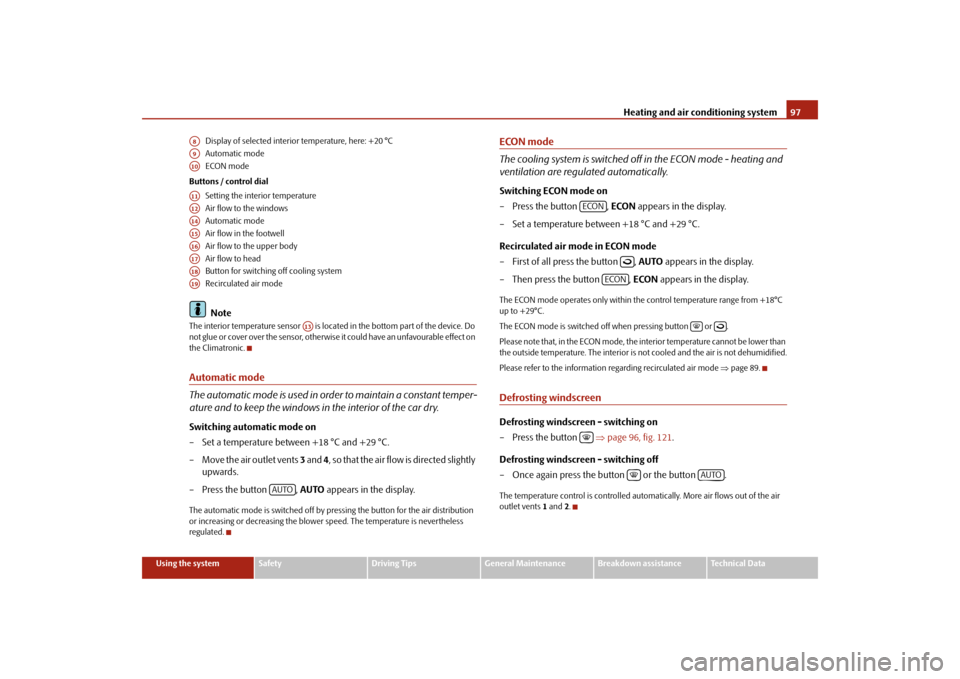
Heating and air conditioning system97
Using the system
Safety
Driving Tips
General Maintenance
Breakdown assistance
Technical Data Display of selected interior temperature, here: +20 °C
Automatic mode
ECON mode
Buttons / control dial
Setting the interior temperature
Air flow to the windows
Automatic mode
Air flow in the footwell
Air flow to the upper body
Air flow to head
Button for switching off cooling system
Recirculated air mode
Note
The interior temperature sensor is located in the bottom part of the device. Do
not glue or cover over the sensor, otherwise it could have an unfavourable effect on
the Climatronic.Automatic mode
The automatic mode is used in order to maintain a constant temper-
ature and to keep the windows in the interior of the car dry.Switching automatic mode on
– Set a temperature between +18 °C and +29 °C.
– Move the air outlet vents 3 and 4, s o t h a t t h e a i r f l o w i s d i re c t e d s l i g h t l y
upwards.
– Press the button , AUTO appears in the display.The automatic mode is switched off by pressing the button for the air distribution
or increasing or decreasing the blower speed. The temperature is nevertheless
regulated.
ECON mode
The cooling system is switched off in the ECON mode - heating and
ventilation are regulated automatically.Switching ECON mode on
–Press the button , ECON appears in the display.
– Set a temperature between +18 °C and +29 °C.
Recirculated air mode in ECON mode
– First of all press the button , AUTO appears in the display.
– Then press the button , ECON appears in the display.The ECON mode operates only within the control temperature range from +18°C
up to +29°C.
The ECON mode is switched off when pressing button or .
Please note that, in the ECON mode, the interior temperature cannot be lower than
the outside temperature. The interior is not cooled and the air is not dehumidified.
Please refer to the information regarding recirculated air mode ⇒page 89.Defrosting windscreenDefrosting windscreen - switching on
–Press the button ⇒page 96, fig. 121.
Defrosting windscreen - switching off
– Once again press the button or the button .The temperature control is controlled automatically. More air flows out of the air
outlet vents 1 and2.
A8A9A10A11A12A14A15A16A17A18A19
A13
AUTO
ECON
ECON
AUTO
s3f4.1.book Page 97 Thursday, June 18, 2009 11:07 AM
Page 99 of 259

Heating and air conditioning system 98Setting temperature– You can set the desired interior temperature after switching on the
ignition with the control dial .You can set the interior temperature between +18°C and +29 °C. The interior
temperature is regulated automatically within this range. If you select a tempera-
ture of less than +18 °C, “LO” is shown on the display. If you select a temperature
above +29 °C, “HI” is shown on the display. In both limit positions the Climatronic
operates at maximum cooling or heating capacity, respectively. The temperature is
not controlled in this case.
Lengthy and uneven distribution of the air flow out of the vents (in particular at the
leg area) and large differences in temperature, for example when getting out of the
vehicle, can result in chills in sensitive persons.Controlling blower
There are a total of seven blower stages available.The Climatronic system controls the blower stages automatically in line
with the interior temperature. You can also, however, adapt the blower
stages manually to suit your particular needs.
– Turn the control dial ⇒page 96, fig. 121 to the left (reduce blower
speed) or right (increase blower speed).If you switch off the blowers, the Climatronic is switched off and OFF is shown in
the display.
The set blower speed is displayed next to the control dial when the respective
number of warning lights come on.
WARNING
•
“Stale air” may result in fatigue in the driver and occupants, reduce
attention levels and also cause the windows to mist up. The risk of having an
accident increases.
•
Do not switch the Climatronic system off for longer than necessary.
•
Switch the Climatronic system on as soon as the windows mist up.
A11
A1
A1
WARNING (continued)
s3f4.1.book Page 98 Thursday, June 18, 2009 11:07 AM
Page 100 of 259

Starting-off and Driving99
Using the system
Safety
Driving Tips
General Maintenance
Breakdown assistance
Technical Data
Starting-off and DrivingSetting steering wheel position*You can set the height and the forward/back position of the steering
wheel to the desired position.
– Adjust the driver seat ⇒page 62.
– Pull the lever below the steering column ⇒fig. 122 down ⇒.
– Set the steering wheel to the desired position (concerning height and
forward/back position).– Then push the lever up against the steering column until it locks into
place.
WARNING
•
You must not adjust the steering wheel when the vehicle is moving!
•
The driver must maintain a distance of at least 25 cm to the steering
wheel ⇒fig. 123. Not maintaining this minimum distance will mean that the
airbag system will not be able to properly protect you - hazard!
•
For s a fe t y re a s ons the le v e r m ust a lwa y s b e fi rm l y pus he d up t o a vo id the
steering wheel altering its position unintentionally when driving - risk of
accident!
•
If you adjust the steering wheel further towards the head, you will reduce
the protection offered by the driver airbag in the event of an accident. Check
that the steering wheel is aligned to the chest.
•
When driving, hold the steering wheel with both hands firmly on the
outer edge in the 9 o'clock and 3 o'clock position. Never hold the steering
wheel firmly in the 12 o'clock position or in another way (e.g. in the middle
of the steering wheel or at the inner steering wheel edge). In such cases,
injuries to the arms, the hands and the head can occur when the driver
airbag is deployed.
Fig. 122 Adjustable steering
wheel: Lever below steering
columnFig. 123 Safe distance to
steering wheel
s3f4.1.book Page 99 Thursday, June 18, 2009 11:07 AM